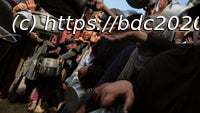The five-part documentary premiering Sunday on National Geographic is at once highly compelling and difficult to watch, though you should.
It’s been 20 years since Hurricane Katrina reshaped the City of New Orleans.
Spike Lee examined the disaster with two big HBO documentaries, the 2006 “When the Levees Broke: A Requiem in Four Acts,” just a year after the event, and a 2010 sequel, “If God Is Willing and Da Creek Don’t Rise,” and is involved with a new work for Netflix, “Katrina: Come Hell and High Water,” arriving in late August. Other nonfiction films have been made on the subject over the years, including “Trouble the Water,” winner of the grand jury prize at the 2008 Sundance Film Festival, Nova’s “Hurricane Katrina: The Storm That Drowned a City,” “Hurricane Katrina: Through the Eyes of the Children,” and “Dark Water Rising: Survival Stories of Hurricane Katrina Animal Rescues,” while the storm also framed the excellent 2022 hospital-set docudrama “Five Days at Memorial.” As a personified disaster with a human name and a week-long arc, it remains famous, or infamous, and indelible.
In the gripping five-part “Hurricane Katrina: Race Against Time,” premiering over two subsequent nights beginning Sunday at 8 p.m. on National Geographic (all episodes stream on Hulu and Disney+ Monday), director Traci A. Curry (“Attica”) necessarily repeats many of Lee’s incidents and themes. But she finds her own way through mountains of material in the series that is at once highly compelling and difficult to watch — though I suggest you do.
Though there are many paths to take through the story, they lead to the same conclusions. Curry speaks with survivors, activists, scientists, officials and journalists, some of whom also appear in archival footage, but her eye is mainly on the victims, the people who lost their homes, people who lost their people, those unable to evacuate, for lack of money or transportation or the need to care for family members. If the storm itself was an assault on the city, most everything else — the broken levees, the flooded streets, the slow government response, the misinformation, the exaggerations and the mischaracterizations taken as fact — constituted an attack on the poor, which in New Orleans meant mostly Black people.
Home
United States
USA — Events ‘Hurricane Katrina: Race Against Time’ focuses on disaster victims, who reflect 20...






